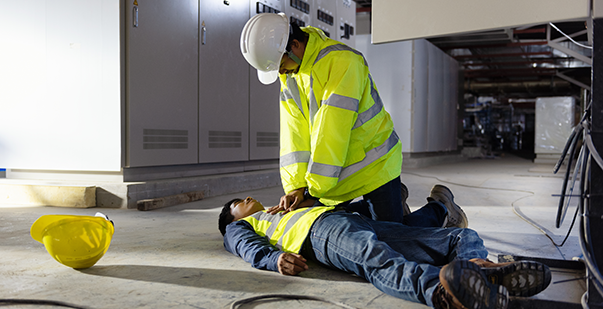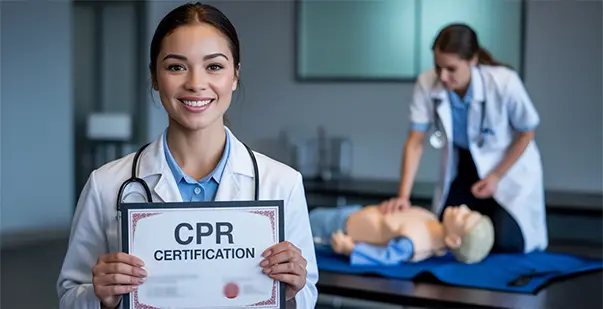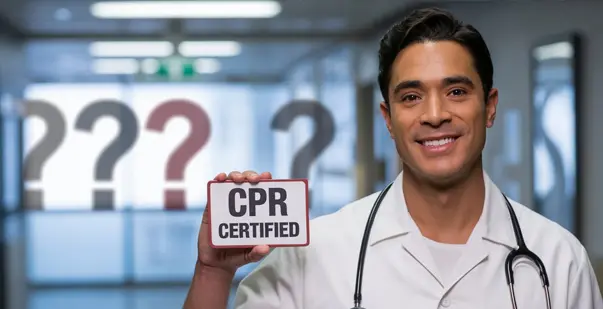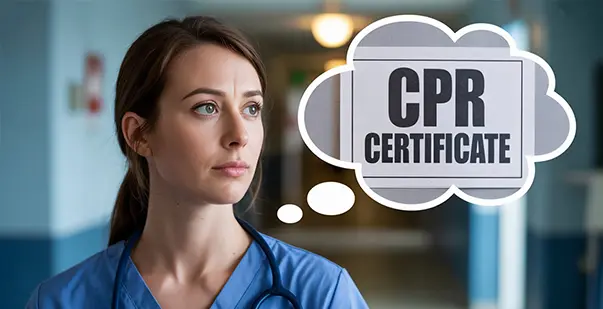How to Renew CPR Certification is a question many people face, when it’s about to expire. According to Harvard Health, only 18% of Americans are currently up to date with their CPR training, even though 65% have been trained at some point. Some people think CPR certification never expires, while others believe renewing it takes too much time and effort.
But today, it's easier than ever to renew. With flexible online options, you can finish most or even all of the process from home, whenever it works best for you. These programs help you update your CPR skills fast while still meeting professional standards. They’re made to save you time. Keep reading to learn how CPR renewal works, when to renew, and how to pick a course that fits your schedule.
Read More: CPR Certification: What It Is & Why it Matters
How to Renew CPR Certification: Step-by-Step Guide
Renewing your CPR certification ensures you stay current with the latest guidelines and maintain readiness to respond effectively in emergencies. The following are the key steps on how to renew CPR certification smoothly:
Step 1. Check Your CPR Certification Expiration Date
Start by looking at your current CPR card to find the expiration date. CPR certifications are usually valid for two years. If your card is still active, you can take a shorter online renewal course. If it’s expired, you may need to take the full course again.
Step 2. Choose a Trusted Online CPR Renewal Course
Select a course that is accredited and accepted by your employer or licensing board. Look for providers recognized by organizations. Be sure the course matches your profession’s CPR level, such as Basic or Healthcare Provider.
Step 3. Enroll and Begin the Online Training
Register for the course and start the training right away. Online CPR renewal classes usually include short videos, step-by-step instructions, and interactive quizzes. You can stop and start as needed, making it easy to fit learning into your schedule without rushing.
Step 4. Complete the Online Assessments
After the lessons, you’ll take a short written test to check your understanding of CPR steps and AED use. Some online programs also include a virtual skills check or ask you to complete a hands-on test at a local training site. Follow the course instructions carefully.
Step 5. Download and Save Your New Certification
Once you pass the test, you’ll receive your new CPR certification, usually instantly by email. Most online providers offer a digital card valid for two years. Save a copy for your records and share it with your employer or licensing agency when needed.
Read More: How Long Does CPR Certification Last? Duration & Renewal Options
What Are The Major Benefits of CPR Recertification?
Renewing your CPR certification is not just about compliance. It’s a way to keep your skills sharp and your response effective. According to the American Heart Association, immediate CPR can triple a person's chance of survival after cardiac arrest. Below are the key benefits of CPR recertification and how they support your ongoing readiness:
Improves Skill Retention
CPR skills can decline quickly without regular practice. However, studies show frequent CPR sessions or recertification refreshes your memory, helping you perform confidently in real-life emergencies. You can relearn chest compression timing, rescue breathing, and AED use.
Maintains Professional Compliance
If you're in healthcare, education, or fitness, CPR certification is often a job requirement. Recertifying helps you stay compliant with your employer’s policies or industry regulations. It also prevents delays in employment or renewal of your license.
Enhances Workplace Safety
When your CPR certification is current, you're ready to respond to cardiac emergencies. This enhances safety for coworkers, clients, and the public, according to the CPR Indianapolis organization. Many workplaces rely on certified staff during high-stress situations.
Offers Flexible Learning Options
Online CPR recertification allows you to complete the entire course from your computer, tablet, or smartphone. There is no need to attend a physical class. Most courses are self-paced, letting you pause and resume anytime. Most classes let you go at your own speed.
Read More: The 10 Benefits of CPR Certification for Construction Workers
When Should You Renew Your CPR Card?
Renewing your CPR card on time helps you stay complaint and avoid any gaps in certification. You should consider getting your certification renewed in the following circumstances:
CPR cards usually last for 2 years. Renew early so you don’t lose your certification.
If you're not sure how to do CPR or use an AED, it's a good idea to take the class again. Being confident is very important in emergencies.
Some jobs need you to have a valid CPR card. Renew it on time so you stay ready and meet your work rules.
CPR guidelines are updated every 5 years. Early renewal ensures your training matches the latest standards.
Common Renewal Mistakes to Avoid
Before you renew your CPR certification, watch out for some common mistakes. Knowing these can help you keep your card up to date.
Waiting Until After Expiration to Renew
Don’t let your card expire before signing up for a class. Make a note of your expiration date and renew early. This way you can opt for shorter and more efficient recertification programs.
Choosing Courses Without Accreditation
Enrolling in non-accredited courses can make your certification invalid. Some jobs or licenses only accept CPR cards from certain training groups. Before you sign up, make sure the class is from a provider that’s accepted in your field. CPR standards change based on new medical research. Failing to learn these updates may reduce your response effectiveness in real-life emergencies.
Forgetting to Save or Share Your Certificate
If you lose your CPR card, it can be a problem when someone asks for proof. To avoid this, download a digital copy and print one out. Most training groups will email your card or let you save it in a digital wallet so it's easy to find later.
Overlooking Advanced Role Requirements
If you’re in a specialized role, such as a nurse, paramedic, or physician, your renewal might need to align with advanced certifications like ACLS or PALS. Check licensure timelines and upgrade your training as needed to meet field-specific standards.
Read More: Need of CPR Programs for Schools & Teachers
Renew Your CPR Certification the Right Way!
Knowing how to renew CPR certification keeps you ready to help when it really counts. Whether you're in healthcare or just someone who wants to be prepared, staying updated is a smart move—and it’s easier than you might think.
Start by checking the expiry date on your current card. Then, pick an online course that works with your schedule. You can take it on your phone, laptop, or tablet—wherever you’re comfortable. Go through the lessons at your own pace, and when you're done, take a quick test to show you’ve got the skills.
Want something quick and flexible? Our 100% online CPR Certification Course. It covers adult, child, and infant CPR. It’s simple to follow, easy to access, and fits into your day. Don’t put it off—renew now and stay ready to step in when it matters most.
References
https://www.redcross.org/take-a-class/cpr/cpr-training/cpr-renewal
https://support.nasm.org/how-do-i-renew-my-cpr-aed-certification
https://www.protrainings.com/blog/renew-cpr-certification-4-steps/










